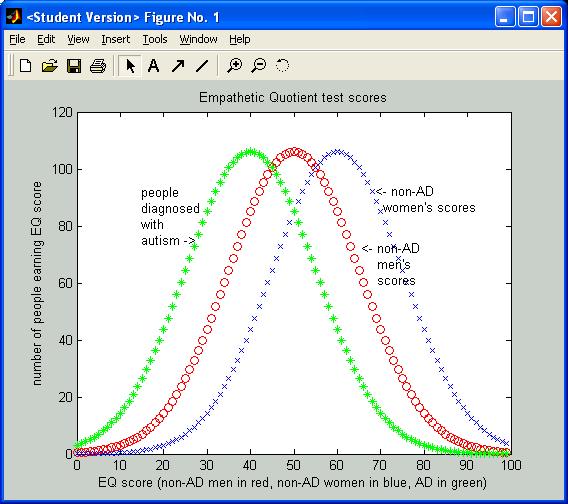
Joe's Autism Page
Men and Women have different Means
Prof. Simon Baron-Cohen shows the difference between high-empathetic brains (as often found in women) and low-empathetic brains (guess whose heads they are found in) by showing the plot of men's scores and women's scores. An example of these two is shown below.

Now here is what I do not understand. The author shows a graph like the one below (see page 151).

I believe that this is fundamentally wrong. I understand that autistics (those suffering from Autism, High-functioning Autism, Asperger's Disorder, or other 'variants' or levels of severity) are not a separate group independent of 'males or females' – the author is merely attempting to show that if all Autistics were pulled out of the underlying population, they would display a distribution ('spectrum') of severity to the 'left' of the typical non-AD male.
The problem is that this model seems to imply that there are some Autistics to the right ('to the right' from the standpoint of the above graph, i.e., more empathetic) of the normally-empathetic women's norm. This is a contradiction of the author's claim that the autism is a disorder characterized by a lack of empathy.
Further, this implication that autistics are characterized by a spectrum extending from 'EQ scores' from 0 to 90 offers no clue, I believe, into the high ratio of male-to-female sufferers. I should note that it is not clear to me whether the author holds this view, or if I am merely over-interpreting hastily presented graphs in his book.
An alternate view.
Let's go back to a view of the distribution of scores for male and female 'empathy IQ' test takers. We see that the norm for men (in this example – which uses made-up data, as do all other examples on this page) is approximately 45 and that the norm for women is about 55. (Both have a standard deviation of 15, again selected for pedagogic purposes.) We can see, given these distributions, that for any low score (e.g., < 40) males are over-represented.
Specifically if we select the score of '20' to be the cutoff, that is, below this we diagnose a person with ASD (though I suspect that this is an oversimplification and that more than a low score would be needed to come to such a conclusion) we see that at 20 there are approximately 4x as many men as women. (Approximately 6 women score '20' on the EQ test, whereas almost 24 men achieve this miserable score.)
The total number of men (or women) achieving a score of 20 or less is that area under the respective curves to the left of the cutoff (shown with a vertical line). Thus if the author is correct that
autism is a disorder that interferes with the ability to empathize (shown by low 'EQ' test scores), and
men in general have weaker empathetic intelligence,
then the overrepresentation of males diagnosed with ASD falls out as a natural consequence and seems to require no further explanation! What does, in this view, require explanation is “why do men in general have lower empathetic intelligence?”
